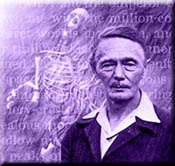
Clark Ashton Smith
Born January 1893  Died August, 1961
Died August, 1961
Clark Ashton Smith was born on January 13th, 1893, in Long Valley, California. He began to write at the early age of eleven. Smith was largely self-educated, having attended grammar school only until the fifth grade. This is amazing, as his work in verse, prose, painting and sculpture is so outstanding. His short stories are filled with poetic writing and imagery. Obviously his gift for poetry influenced his other work. Whether in poetry or prose, Smith's colorful, baroque pieces relied on irony and the rich fantasy worlds in which his stories breathed life.
Smith was selling stories to The Black Cat, The Overland Monthly, and other magazines at the ripe age of seventeen. His first collection of verse was published only two years later, and he was acclaimed as a prodigy. His style of work was said to be equal to Chatterton, Rossetti and Bryant. It was not, however, till Smith was thirty-five that he came into his own, when his short piece "The End of the Story" was included in the publication Weird Tales. This story certainly inspired more tales of the weird, macabre and pseudo-scientific, a genre very popular with readers. Clark was very prolific. His poetry was published in over fifty magazines, including The Yale Reviews, Poetry: A Magazine of Verse, The Philippine Magazine, The London Mercury, Munseys, Asia Wings and The Mencken Smart Set. His poetry has been included in more than a dozen anthologies.
Smith's book-length publications were all printed in limited editions, making them collectors' items today. Four of his five volumes are of verse: The Star-Treader, Odes and Sonnets, Ebony and Crystal, and SandalWood. The fifth volume is a pamphlet of tales entitled The Double Shadow and Other Fantasies. Although Clark Ashton Smith, the poet, wrote over 700 works of poetry and prose, he is better known today for his short stories. Critics say that the ultimate exhibition of his work is his prose. Smith presented it to his readers here in the US and abroad in the collection entitled Out of Space and Time. He personally selected the stories to appear in this volume.
Smith's talent in prose and poetry was only the tip of the creative iceberg. He was also an accomplished painter and sculptor, and many of his bizarre pictures and carvings were exhibited to the public. In creating his sculptures he used unusual minerals, and critics have likened his work to pre-Columbian art. His sculptures were powerful pieces, but being they were not widely circulated, each one is an original. There are no copies. His paintings also met with some acclaim, and his work was compared to the famous symbolist Odilon Redon.
Clark Ashton Smith worked a variety of jobs in his first forty-eight years. He was a journalist, a gardener, a typist, a fruit picker/packer, a wood chopper, a cement mixer, a hard-rock miner, a mucker (to move or load muck, as in a mine) and a windlasser (one who uses various machines for hoisting or hauling). Funny, isn't it, because his poetry and verse would make one think that Smith lived in an elite world. But the truth of his life was far from it.
Smith's poetry shows the distinct influence of French symbolists. But also very evident are the thumbprints of his great and good friends George Sterling and H. P. Lovecraft. The tales in Out of Space and Time represent a variety of ideas and reveal the many facets of Smith's outstanding abilities in prose. Even though Smith was not as well known by the public at large, he did make his mark throughout the genres of Science Fiction and Fantasy. One could say that Clark Ashton Smith was America's greatest writer of the macabre and fantastic. He is certainly considered the greatest stylist in the genre. Smith never limited himself to only one style of work, but instead opened the doors wide to explore all areas of his creativity and through his publications, he allowed his fans to explore those areas with him. Here are some of his poetry that you might like to check out:Clark Ashton Smith's Poems
And if you are fond of his poetry, then certainly check out "Averoigne" and the tales belonging to the "Cthulhu Mythos." Also worth a look are his stories of sheer horror and one or two of sardonic comedy such as "The Weird of Avoosl Wuthoqquan". Perhaps you would enjoy his popular science-fiction novelette "The City of the Singing Flame" and its sequel. His classics of the weird including "The End of the Story," "A Night in Malnéant," "The Double Shadow", "The Return of the Sorcerer", and "The Dark Eidolon" should be on your must-read list.
It was with sadness to the world that this grand master of fantasy, horror and science-fiction died in August, 1961 at the young age of 68. His death deprived us of one of sci-fi's most unequaled, undisputed leaders. There is no one who can really match Smith in the tiny nook he created for himself, though several have tried. The saddest news however is that many of his stories are now out of print. For the truly interested, try EBay. Some of his works are still readily available through second hand dealers.
Biography by Z
Submitted on 4.30.03
The Eldritch Dark is a site to facilitate both scholars and fans in their appreciation and study of Clark Ashton Smith.
Ragged Entelechy
by Fiona Webster
Science Fiction and Fantasy Poetry Clark Ashton Smith's Poetry by Jonathan Vos Post